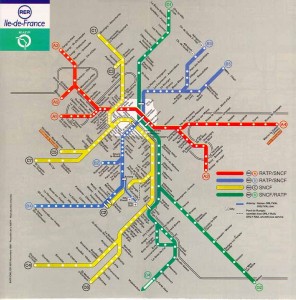 Compared to many other mass transit systems throughout Europe, the Paris Metro is particular for several reasons. Second only to Moscow’s transit system in terms of number of humans moved annually, the Metro is an incredibly dense network of lines that allow anyone to get virtually anywhere throughout the city and the surrounding suburbs. This density and reliance has been layered atop the original plans for the system designed and implemented over a century ago. Indeed, of all the things you’re initially bound to notice about the Metro, is that it shows its age with pride.
Compared to many other mass transit systems throughout Europe, the Paris Metro is particular for several reasons. Second only to Moscow’s transit system in terms of number of humans moved annually, the Metro is an incredibly dense network of lines that allow anyone to get virtually anywhere throughout the city and the surrounding suburbs. This density and reliance has been layered atop the original plans for the system designed and implemented over a century ago. Indeed, of all the things you’re initially bound to notice about the Metro, is that it shows its age with pride.
Descending into any given station you’re sure to at some point encounter a dank smell in the air – the infamous ripe aroma of the Parisian subway system. Thousands of years of humans living and dying in the same twenty-mile radius will get you some interesting odors beneath the depths of the streets. In fact, this has little to do with the system itself and more to do with the fact that the stagnancy of sewage flow in Paris has been a problem for many years. The real initial indicators that you might be literally getting in over your head require a prepaid cell phone to capture.
Common is the falling chunk of ceiling plaster (of Paris?) that lands a few meters to your right as you wait to buy your ticket. Looking up, you see that the whole hole that you’re currently standing in looks like it’s about to collapse. Deep cracks cover the walls, water drips from every crevice, and that lingering odor does nothing to reassure you that your environment is safe. The only relief seemingly comes from seeing electric cables spilling out from overhanging grates – proof that at least someone has been inspecting something recently.
You purchase your ticket and descend further, and the stink grows thicker as your stomach gets tighter. You’d sit on the available bench on the platform as you wait, but not only is there either saliva or ceiling water or both puddling in the seat, the chunks of ceiling above the bench are waiting for the rumble of the inbound train to fall. Alas, your train arrives, and while the tile doesn’t fall from the shake of the subway cars, you remember that glob of ooze and remind yourself it was still smart to stand.
Riding in the car, you become alarmed by the fact that it’s the year 2011 and you’re in a subway car with open windows as it rattles through the blackened tunnels beneath the City of Lights. You can hear the sounds of an oncoming train bouncing off the walls and through the open window, as well as the growing yellow of its lights, and you close your eyes and wince…
…the oncoming train shoots past the side of yours, and you slow down to your stop. Realizing it wasn’t so bad, you happily ascend up to the streets of Paris and enjoy your sight-seeing. You casually repeat the process over and over, using the rapid and reliable system to get to everywhere you want to be in Paris.
Upon arriving back to your hometown, you’ll inevitably get a whiff that reminds you of the Paris Metro. It’s then that you’ll realize that you miss that stinky, slimy subway, and could never imagine an enjoyable Parisian experience without it.


